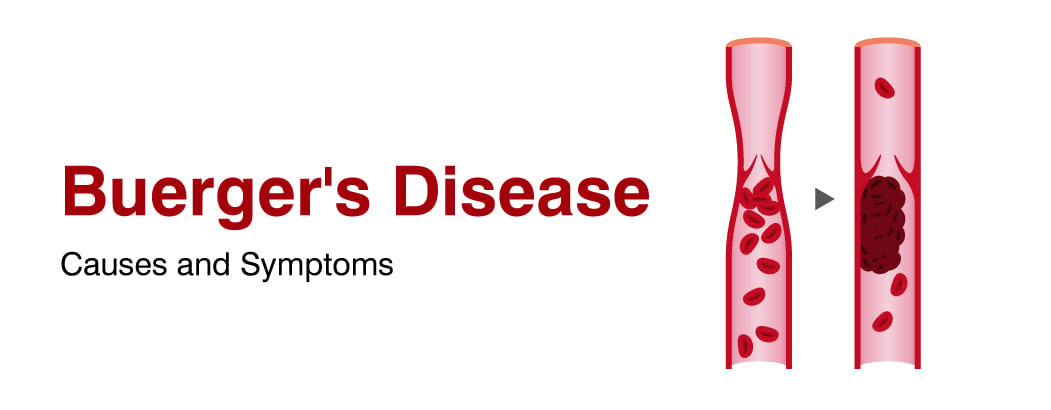Buerger’s Disease: Causes and Symptoms
November 21, 2023

What is Buerger’s disease?
One of these examples includes Buerger’s disease or thrombangiitis obliterans which is a rarely encountered disorder that affects the vessels, specifically arteries found in the hands and feet. Inflammation and clumping of blood in the blood vessels results into decreased blood flow which might cause damage to the tissues. The main victims of this disease include young and middle-aged persons especially people who use tobacco products such as cigarettes and smoking. These individuals manifest signs such as pain, numbness and ulcer formation. Although the causative factor is yet to be identified, cigarette smoking strongly suggests that smoking cessation should be emphasized as a management strategy for hypertensive cardiomyopathy in order to prevent its progression and development into HF. Lifestyle changes and early diagnosis are vital for stopping Buerger’s disease and improving vascular health.
Table of Contents
- What is Buerger’s disease?
- What are the symptoms of Buerger’s disease?
- What causes Buerger’s disease?
- What are the risk factors for Buerger’s disease?
- How is Buerger’s disease diagnosed?
- What treatments are used for Buerger’s disease?
- Conclusion
- Frequently Asked Questions
What are the symptoms of Buerger’s disease?
A rare condition called Buerger’s disease or thromboangiitis obliterans mainly affects the arteries of the extremities (arms and legs). It is important to recognize the symptoms, especially those related to gangrene, as this will facilitate a timely diagnosis and treatment.
-
Persistent Pain:
The main symptom of Buerger’s disease is constant pain, predominantly in the hands and feet. Such a distress usually aggravates during activity accompanied by muscle aches.
-
Cold or Numb Extremities:
Buerger’s disease patients often complain about sensation of coolness and even numbing in the extremities. It comes about because of weakened blood circulation resulting from vascular wall irritation and thrombus formation.
-
Skin Changes:
The development of gangrene symptoms occur due to alterations that take place on the skin as Buerger’s disease progresses. Check for skin with a pale hue, reddish patches, and marbled appearance. Open wounds that take the form of ulcers or sores arise as the disease worsens.
-
Limited Range of Motion:
Poor blood flow may cause reduced range of movement in the involved arms or legs. Weakness and fatigue are the common accompaniments of this mobility limitation.
-
Tissue Death (Gangrene):
In extreme cases of compromised blood supply, it leads to a situation called “gangrene”. This is an emergency complication and necessitates proper medical action. Gangrene leads to a blackening or discolouring of the skin, an unpleasant smell, and danger of infection.
Early diagnosis of Buerger’s disease depends on recognising these symptoms. A person exhibiting these symptoms must seek immediate medical attention to properly treat the illness and avoid the associated complications.
What causes Buerger’s disease?
Gangrene is one of the most threatening complications developing in this disease process. But what causes this terrible condition?
Smoking:
Smoking ranks as one of the major risk factors in Buerger’s disease. These toxic chemicals can cause inflammation and vascular damage, thereby facilitating blood clotting. The clots tend to block the flow of blood in most cases leading to low concentration of oxygen in addition to a high probability of gangrene.
Immune System Response:
It has been thought that the condition is due to an impaired immunologic reaction. However, at times the immune system can be tricked into attacking the arteries (resulting in inflammation) and subsequently gangrene and clot formation.
Genetic Predisposition:
However, the genetics associated with Buerger’s disease have been demonstrated, and some level of evidence may be used to substantiate that assertion. They suggest that those who have had the same disorder in their families are more likely to get the same illness due to genetics.
To prevent it and detect it at an early stage, it is important to identify the causes of Buerger’s disease, including its role in gangrene. Modifying other risk factors enables one to reduce their blood pressure, make healthy vessels by stopping smoking etc.
What are the risk factors for Buerger’s disease?
- Tobacco Use:
The most important risk factor of Buerger’s Disease is smoking habits of tobacco. Tobacco products of any kind, including smoking, significantly exacerbate this vascular disease. Tobacco contains harmful chemicals which may lead to blood vessel destruction leading to inflammation making the way to Buerger’s disease.
- Age and Gender:
Young to middle aged adult mostly affected by this disease are those that ranged from age 20 to 40. Men also have a greater likelihood of contracting it despite the unknown gender disparity.
- Genetic Predisposition:
Genetic factor has been observed in case of Buerger’s disease. The risk might, therefore, be higher in people whose families have had the condition before. Despite poor knowledge on the exact gene inherited in every family, your past med-case should be considered important.
- Geographical Influence:
However, what is quite interesting is that Buerger’s disease typically occurs in specific areas rather than globally. There are a high percentage of cases reported across Asia, the Middle East and among areas with high levels of smokeless tobacco usage. The explanation of the location specificity is still under research.
- Inflammatory Conditions:
Those who have experienced chronic inflammation like lupus, and rheumatoid arthritis are at more risks of contracting, Buegers’s disease. Inflammations associated with these conditions may cause Büerger disease’s vascular complications.
How is Buerger’s disease diagnosed?
The timely diagnosis may be critical in case of the possible complications like gangrene. In short, this is what healthcare experts use to recognize Buerger’s disease.
- Clinical Evaluation:
It all starts with a thorough clinical evaluation. They look into symptoms like pains, discolouration and reduction in pules in the extremities scanned by physicians. The initial analysis is very important because it leads to more exploration.
- Ankle-Brachial Index (ABI):
Ankle brachial index (ABI), a non-invasive test which records pressure in both ankles and arms. A high ABI in the unaffected limb can indicate increased blood supply whereas a low ABI in the affected one points to poor circulation, indicating Buerger’s disease.
- Doppler Ultrasound:
Dopler ultrasonography uses sound waves to image blood flow in the arteries. The tool help diagnose any irregularities including blood blot or vessel narrowing.
- Angiography:
Angiography is an invasive investigation procedure where contrast dye is injected into blood vessels and subsequently seen as X-ray images after being made visible. This method makes it possible to accurately visualize arteries and identify the Buerger’s disease affected parts.
Early detection of Buerber’s disease is critical because of its ability to develop into a severe condition known as gangrene. Healthcare providers and patients need to work together in order to prevent or reduce these complications that may arise from vascular disease.
What treatments are used for Buerger’s disease?
-
Smoking Cessation:
Of all the factors necessary for successful Buerger’s disease management, none can match the importance of total and prompt cessation of smoking. The only known measure that can reduce the disease and stop its advancement is to quit smoking. Patients are severely counseled to quit smoking as a way of stopping the progressive injury of the blood vessels by the inflammatory process.
-
Medications:
There are instances where drugs can be administered to help in symptomatic relief and control of pain. Some drugs in the category of vasodilators, like calcium channel blockers, can dilate constricted blood vessels thereby increasing delivery of blood to the stricken areas. Other pain relieving drugs such as prostaglandin analogues be prescribed to comfort the painful symptoms that accompany labour.
-
Clot-Dissolving Drugs:
Thrombolytic drugs such as thrombolytics are prescribed to avoid blood clot formation within affected vessels. Such drugs disintegrate clots and improve circulation that will reduce damage to tissues and hence avert amputation.4
-
Sympathectomy:
For severe cases, surgical interventions such as sympathectomy can be provided. In this process blood vessels are dilated by cutting or pressing the nerves that regulate the tightening.
-
Hyperbaric Oxygen Therapy (HBOT):
Hyperbaric oxygen therapy (HBOT) helps some of the patients as they inhale pure oxygen under pressure in pressurized rooms or chambers.+print”> It enhances the oxygen delivery to the tissues, thereby facilitating healing wounds and minimizing symptoms.
The use of these medicinal therapies may temporarily ease the symptoms and stall the disease. Still, one should seek advice of his/her physician to determine what is appropriate in his or her unique situation. Early detection and total management is important for the treatment as it greatly involves complex processes.
Conclusion:
In conclusion, Buerger’s disease poses a significant risk to vascular health, particularly affecting young and middle-aged children, especially those with a history of tobacco use Initial symptoms such as persistent pain, nausea, and detection of skin changes are important for timely diagnosis. Smoking cessation stands out as an important management strategy because of its strong association with disease. Genetics, age and inflammatory conditions also play a role in its development. Diagnostic procedures include clinical examination, ankle and brachial index testing, Doppler ultrasound, and angiography. Treatment options include smoking cessation, medications, vasoconstrictors, compassionate dissection, and hyperbaric oxygen therapy. Early diagnosis and management are essential to prevent Buerger syndrome and reduce its serious complications.
Frequently Asked Questions
1. What are the 5 criteria for Buerger’s disease?
Buerger’s disease, additionally known as Thromboangiitis obliterans, is identified based on five standards: age below 50, cutting-edge or latest history of tobacco use, distal limb ischemia (confined blood waft to extremities), function vascular lesions, and the absence of atherosclerotic threat factors other than tobacco use.
2. What is Buerger’s disease caused from?
The precise motive of Buerger’s sickness isn’t always fully understood, but it’s far strongly related to tobacco use. Smoking is considered the number one threat factor, and the disease is more widespread in folks who smoke or use tobacco products. The inflammatory reaction induced with the aid of tobacco is assumed to play a key function inside the improvement of Buerger’s disorder.
3. What is the most common artery involved in Buerger’s disease?
Buerger’s disease normally influences small and medium-sized arteries, particularly those in the extremities. The arteries of the arms and ft are most usually concerned. The irritation and clotting that arise in those arteries cause decreased blood flow, inflicting symptoms along with ache, numbness, and tissue damage within the affected limbs.








